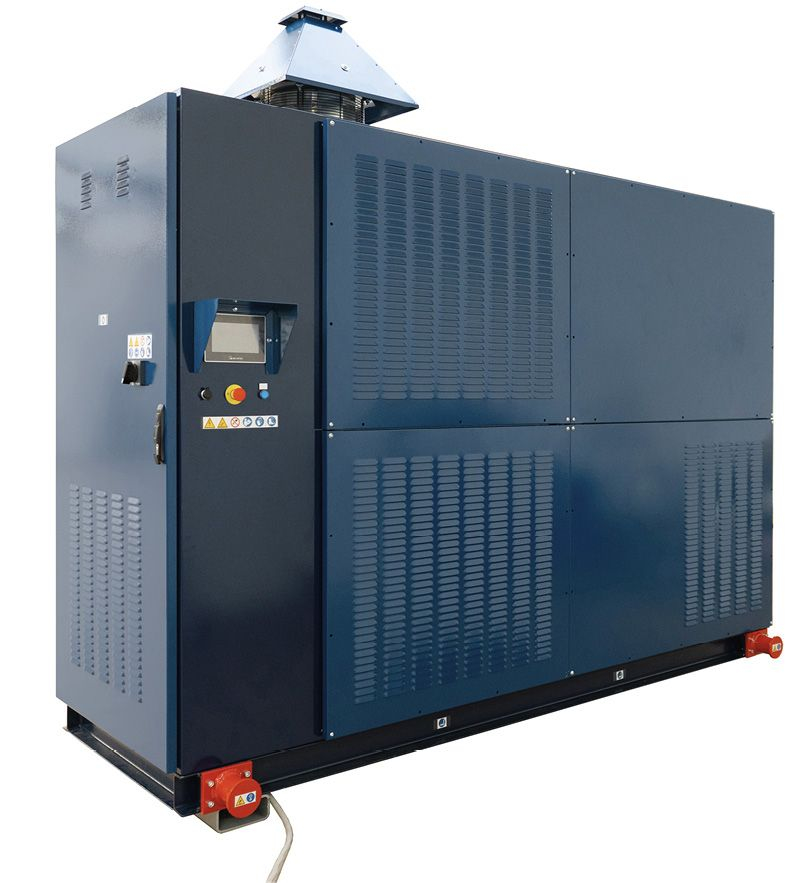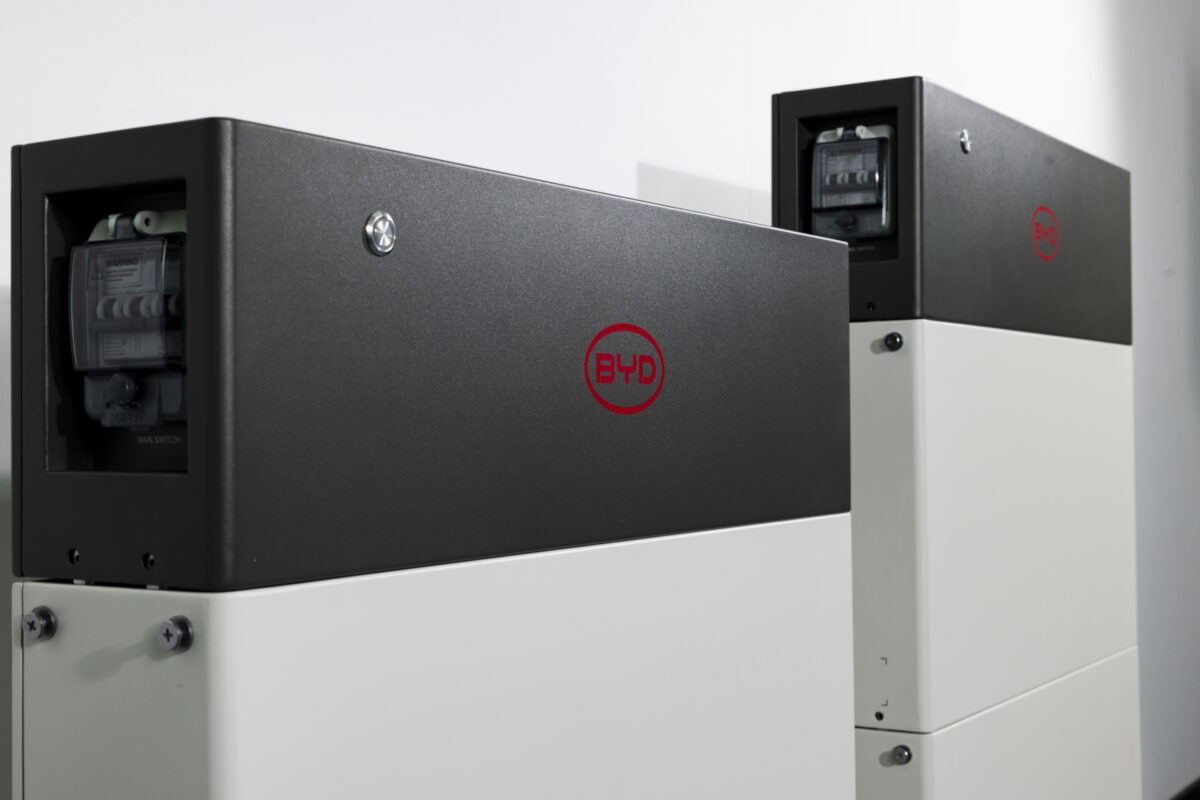From pv magazine 02/23
Converting all of today’s fossil-fueled gray hydrogen production into the green form of the energy carrier would require 950 TW of electrolyzer capacity. With four to five PW of electrolyzer capacity expected by 2050, the European Patent Office and the IEA expect four different electrolyzer technologies to dominate the field.
Alkaline water electrolysis, which involves two electrodes made of a non-noble metal (typically nickel) operating in a liquid alkaline electrolyte solution, is the oldest technology. Polymer electrolyte membrane (PEM) electrolysis, introduced in the 1960s as a fuel cell technology, comprises a solid polymer electrolyte and has already been commercialized. Solid oxide electrolyzer cells (SOEC), which are in a pre-commercialization demonstration phase, use a solid oxide – or ceramic – electrolyte to produce hydrogen gas. Finally, anion exchange membrane (AEM) technology is an evolution of alkaline water electrolysis and is currently going through a market uptake phase.
Rising investment
In the last decade, PEM electrolysis and SOEC systems have registered a larger number of published international patent families than alkaline water electrolysis. Triggered by decarbonization efforts and tight energy markets, electrolysis investment is speeding up and also shifting focus.
“The open grants for academic work were more focused on increasing the efficiency of the cell, and on the right materials for the electrocatalyst and the membrane,” says Andras Perl, a scientist at the “Entrance” (Energy Transition Center), Centre of Expertise Energy at the Hanze University of Applied Sciences in the Netherlands. “Now the focus is mostly on upscaling, and eventually increasing the economics of the electrolysis; how you can make something commercially viable from the process, not only hydrogen. Hydrogen peroxide is an example.”
Primary investment currently targets cheaper materials, serial production, and increased automation of cell manufacturing. Industry observers expect costs to go down but have refrained from making cost predictions. At this stage, radical innovation such as hydrogen production directly from the sun, without electricity, is expected to remain on the fringes of the electrolyzer market.
“I don’t see the industry embracing, any time [soon], technology based on light-activating electrocatalysts,” says Perl. “It is more of a university research focus.” The Hanze University scientist explains that scaling up technology from the lab can be tricky, as system stability can prove difficult to achieve.
PEM technology
European companies are working on optimizing their products, primarily focusing on their core businesses. “We are currently concentrating on further improving our PEM electrolyzer technology,” says Manuel Kuehn, head of sales for sustainable energy systems at Siemens Energy. PEM electrolyzers operate at higher pressures and current density, meaning they occupy less space than alkaline water electrolysis systems.
In the field of PEM electrolyzer production, as with its predecessor technology, original equipment manufacturers are coming up with a one-size-fits-all solution, at least for now. They expect to optimize their products as a function of local needs when the industry becomes more mature.
“Right now, there is not yet the order volume or the staff to work on different system configurations,” says Kuehn. “At some point, however, this will be the case.” Projects are still comparatively small but are gaining practical experience in the field. “This is the only way to improve our confidence in the long-term viability of the technical solutions,” he adds. “With better data, we can support our customers to get the projects financed.”
AEM technology
Hyter, part of Italy’s Pietro Fiorentini gas group, is betting on AEM water electrolyzers (AEMWE). Set for the commercial stage, the company is producing and selling its AEMWEs, all with in-house stack chemistry.
“We are the company currently producing the largest AEMWE sizes available on the market, with our Rigel stack producing 2 Nm3 [normal meter cubed]/hr and the ambitious target of perfecting our Sirius stack concept within the next months, which would produce 50 Nm3/hr of hydrogen alone,” says Massimiliano Masperi, product specialist at Hyter.
Masperi says that, as with other AEMWE developers, Hyter experienced technical difficulties with a few prototypes but it has now finalized an engineering concept. “Not considering the balance of the plant, we reached 4.3 kWh per Nm3 of hydrogen produced, at 25 bar of output pressure, and high purity of 99.95% without a purification unit,” says Masperi, explaining that the AEM technology is up and coming for three reasons.
The electrolyzer type reached reaction efficiencies “that are highly competitive compared to all other technologies,” says Masperi. At the same time, by using a lower alkaline electrolyte concentration, Aemwe does not require noble metals in the cells. It also benefits from cells that can stand working pressures up to 25 bar, hence skipping the first compression stage. “So in the end, the levelized cost of hydrogen between AEMWE and other technologies, when comparable in dimension and sizing, is lower,” he adds.
Hanze University scientist Perl says the main drawback of AEM technology is the plant’s design and balance, which reportedly require additional work. Hyter disagrees.
Alkaline electrolyzers
A 2018 paper by Karim Ghaiba and Fatima-Zahrae Ben-Fares found the operating – electricity-to-hydrogen – efficiency of alkaline electrolyzers to be between 62% and 82%, compared to 67% to 82% for PEM systems. Solid oxide efficiency is yet to be clarified.
PEM and AEM technologies can ramp up and down faster than alkaline electrolyzers but the difference, albeit relevant in a laboratory, is less visible in large scale installations. Units take some time to adjust to energy input, both in the case of PEM and alkaline systems, as the additional components around the stack require time.
Ulf-Steffen Bäumer, head of innovation center, service and digitalization at German electrolyzer manufacturer ThyssenKrupp Nucera, says, “When you apply renewable energy in 5 GW applications, this won’t fluctuate in a fraction of a second. These fluctuations could take minutes. So the difference between PEM and alkaline is limited in real applications. PEM and alkaline will both have their strengths.” ThyssenKrupp is focusing on alkaline technology.
Bäumer explains the company has carried out chloralkali electrolysis since the the early 1980s. In this case, the cathode side, the hydrogen production, is the same. “This is a significant advantage for big-scale projects,” he says. “There is an existing manufacturing supply chain. So we have a supply chain of 1 GW already, which will increase, in the next years, to 5 GW.”
Additionally, like AEM systems, chloralkali electrolysis uses a limited amount of noble metals.
ThyssenKrupp Nucera is designing and selling standardized 20 MW modules. “Each consists of the electrolyzers, the stack, and some core equipment to close the electrolytes of the liquid electrolyte cycle, and hand over the hydrogen gas with the reduced water entrainments,” adds Bäumer. “This is the case in all the geographies. Minimal adaptations are required.”
The tendency for alkaline water electrolyzer technology is to go higher in temperature but ThyssenKrupp considers increasing the temperature as a topic for the future, not for current optimization efforts. “We operate our chloralkali electrolyzers at 90 C, which is already quite high,” says Bäumer.
SOEC technology
From a thermodynamic point of view, the electrolysis process has higher electronic efficiency at higher temperatures. The system needs less electricity but requires a heat source. Experts agree that SOEC technology has an advantage in this respect, working at between 600 C and 800 C. Providers are now focusing on increasing stability for this temperature range.
“I don’t see a lot of solid oxide electrolyzers,” says Perl. “I saw more body of work about solid oxide fuel cells.”
Industry insiders say that there is room for various electrolysis technologies in the long run, as demand will be so high that no single technology, nor a limited number of companies, will be able to satisfy the appetite for green hydrogen equipment. At the same time, merger and acquisition operations are to be expected.
“Many new players are evolving: new companies entering into this field, from startups to companies from fields unrelated to chemical plants,” says Thyssenkrupp’s Bäumer. “It is a very dynamic environment. From a business perspective, there will be consolidation, as is happening now. Still, there will be big players but also local players.”
This content is protected by copyright and may not be reused. If you want to cooperate with us and would like to reuse some of our content, please contact: editors@pv-magazine.com.



10 comments
By submitting this form you agree to pv magazine using your data for the purposes of publishing your comment.
Your personal data will only be disclosed or otherwise transmitted to third parties for the purposes of spam filtering or if this is necessary for technical maintenance of the website. Any other transfer to third parties will not take place unless this is justified on the basis of applicable data protection regulations or if pv magazine is legally obliged to do so.
You may revoke this consent at any time with effect for the future, in which case your personal data will be deleted immediately. Otherwise, your data will be deleted if pv magazine has processed your request or the purpose of data storage is fulfilled.
Further information on data privacy can be found in our Data Protection Policy.